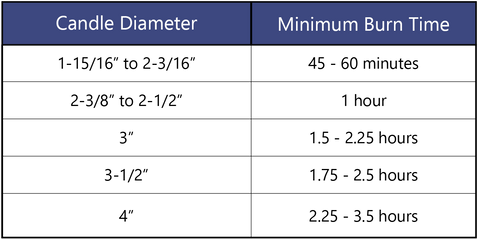Careful preparation will contribute significantly to the performance of your Marklin candle. As you set up your candle, please keep the following guidelines in mind.
Although lighting candles is a common task, sometimes important steps are overlooked.
As your candle burns, here are some things to watch out for:
Please refer to the chart below to determine the appropriate burn times for your candle size:

In proper candle care, the end of the life of the flame is as important as its beginning.
When all of the above guidelines are followed, your candle should perform as expected. Below, we list for you some adverse performance symptoms, the cause, and a corrective measure to be taken.
This is a sign of either the wick being too long or a draft being present. If necessary, trim the wick to the appropriate length. Also, make sure that the candle is away from any drafts.
When your candle is not allowed to burn long enough each time that it is lit, cratering will eventually occur. Follow the recommended burn time for your candle.
A candle that is not sitting straight in its holder will start to bend in whatever direction it is leaning. Make sure that it is sitting straight by looking at it from all directions.
If your candle's wick becomes too short to support a strong flame, or if cratering has occurred, it may be necessary to recondition the candle.
1) Begin about 5 to 10 minutes after extinguishing the flame. The candle top should still be warm.
2) Slowly remove the follower.
3) Use a sharp knife to slowly trim away any outer edge of the candle top.
4) With a spoon, gently remove the soft wax in the pool around the wick, carving almost out to the edge, removing any contaminants such as match heads or wick pieces, until the proper length of wick is exposed.
5) Completely clean all wax from follower and any drippings from the side of the candle.
6) Replace the follower firmly onto the candle top by gently resting the follower on the top of the candle and securing it with a quarter turn.
7) Relight your reconditioned candle.